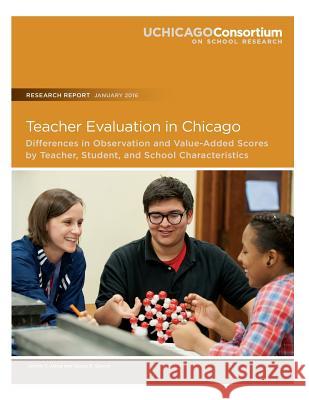Teacher Evaluation in Chicago: Differences in Observation and Value-Added Scores by Teacher, Student, and School Characteristics » książka
Teacher Evaluation in Chicago: Differences in Observation and Value-Added Scores by Teacher, Student, and School Characteristics
ISBN-13: 9780990956365 / Angielski / Miękka / 2016 / 48 str.
Teacher Evaluation in Chicago: Differences in Observation and Value-Added Scores by Teacher, Student, and School Characteristics
ISBN-13: 9780990956365 / Angielski / Miękka / 2016 / 48 str.
(netto: 61,14 VAT: 5%)
Najniższa cena z 30 dni: 63,84
ok. 16-18 dni roboczych.
Darmowa dostawa!
This report finds teachers with the lowest scores on the REACH Students teacher evaluation system are overrepresented in schools serving the most disadvantaged students, while teachers with the highest observation scores are underrepresented in these schools. The study uses data from the 2013-14 school year, which represents the first comprehensive snapshot of evaluation scores for Chicago Public School teachers under the new REACH Students teacher evaluation system. This includes value-added scores based on students' gains on tests, as well as scores from observations of teaching practices in classrooms. It finds 26 percent of teachers with the lowest value-added scores are in schools with the highest concentrations of poverty, while 13 percent are in schools with the lowest concentrations of poverty. The differences in observation scores are more pronounced: 30 percent of the lowest-scoring teachers are found in the highest-poverty schools, while only 9 percent are in schools with the lowest poverty. In other words, observation scores have a stronger relationship with school characteristics, such as poverty, than value-added scores. While more research needs to be done in Chicago to understand why these differences exist, other research suggests these differences could arise because it is more difficult to recruit and retain high-scoring teachers in high-poverty schools, or because it is more difficult to get a high observation score if teaching in a high-poverty school. The report also finds teachers in schools with better organizational and learning climates tend to have higher value-added and observation scores, and these differences remain significant when comparing schools with similar student characteristics, including poverty level. REACH and other teacher evaluation systems employ multiple measures to capture different aspects of teacher performance. Value-added scores are intended to capture student growth on test scores, and explicitly control for measures of student disadvantage, such as poverty and previous achievement. Observation ratings are intended to capture a teacher's level of instructional practice, and do not control for any student or school characteristics, such as poverty. The study also finds that, on average, African American, Latino, and other minority (i.e. Asian, Hawaiian/Pacific Islander, Native American, and multi-racial), teachers' observation scores are lower than white teachers' observation scores. However, for African American teachers, who are overrepresented in the highest-poverty schools, most of this difference seems to be due to the relationship between observation scores and school characteristics, such as school-level poverty. There were no significant differences by teacher race/ethnicity on either reading or math value-added scores.











